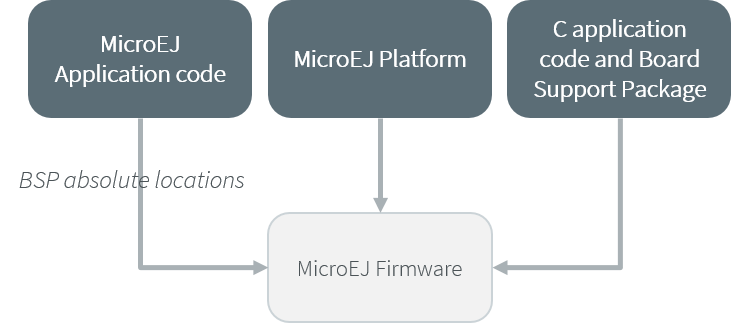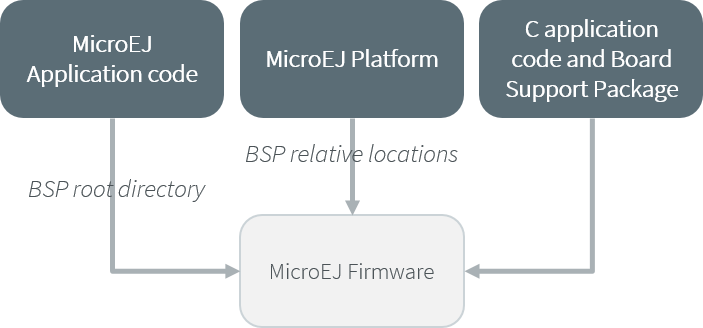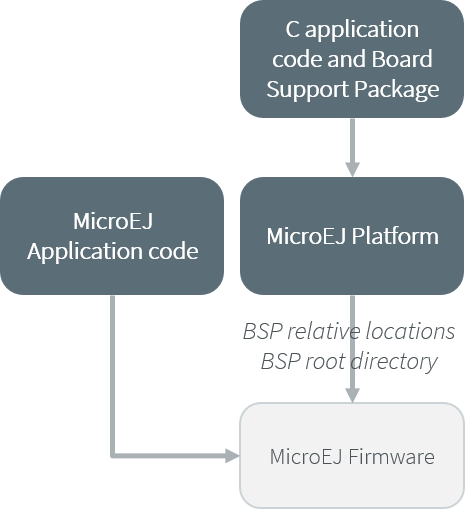BSP Connection
Principle
Using a VEE Port, the user can compile an Application on that VEE Port.
The result of this compilation is a microejapp.o file.
This file has to be linked with the VEE Port runtime file (microejruntime.a)
and a third-party C project, called the Board Support Package (BSP),
to obtain the final binary file (the Executable).
For more information, please consult the MicroEJ build process overview.
The BSP connection can be configured by defining 4 folders where the following files are located:
Application file (
microejapp.o).VEE Port runtime file (
microejruntime.a, also available in the VEE Portlibfolder).VEE Port header files (
*.h, also available in the VEE Portincludefolder).BSP project build script file (
build.batorbuild.sh).
Once the Application file (microejapp.o) is built, the files are then copied to these locations
and the build.bat or build.sh file is executed to produce the Executable (application.out).
Note
The final build stage to produce the Executable can be done outside of the SDK, and thus the BSP connection configuration is optional.
BSP connection configuration is only required in the following cases:
Use the SDK to produce the Executable of a Mono-Sandbox Application (recommended).
Use the SDK to run a VEE Port Test Suite on device.
Build a the Executable of a Multi-Sandbox Application.
MicroEJ provides a flexible way to configure the BSP connection to target any kind of projects, teams organizations and company build flows. To achieve this, the BSP connection can be configured either at VEE Port level or at Application level (or a mix of both).
The 3 most common integration cases are:
Case 1: No BSP connection
The VEE Port does not know the BSP at all.
BSP connection can be configured when building the Application (absolute locations).

VEE Port with no BSP connection
This case is recommended when:
the Executable is built outside the SDK.
the same VEE Port is intended to be reused on multiple BSP projects which do not share the same structure.
Case 2: Partial BSP connection
The VEE Port knows how the BSP is structured.
BSP connection is configured when building the VEE Port (relative locations within the BSP), and the BSP root location is configured when building the Application (absolute directory).

VEE Port with partial BSP connection
This case is recommended when:
the VEE Port is used to build one Application on top of one BSP.
the Application and BSP are slightly coupled, thus making a change in the BSP just requires to build the Executable again.
Case 3: Full BSP connection
The VEE Port includes the BSP.
BSP connection is configured when building the VEE Port (relative locations within the BSP), as well as the BSP root location (absolute directory). No BSP connection configuration is required when building the Application.

VEE Port with full BSP connection
This case is recommended when:
the VEE Port is used to build various Applications.
the VEE Port is validated using Test suites.
the VEE Port and BSP are delivered as a single standalone module (same versioning), perhaps subcontracted to a team or a company outside the Application project(s).
Options
BSP connection options can be specified as VEE Port options or as Application options or a mix of both.
The following table describes the VEE Port options.
In SDK 6, the options must be set in the configuration.properties file of the VEE Port project , prefixed by bsp..
In SDK 5, the options must be set in the bsp/bsp.properties file of the VEE Port configuration project.
Option Name |
Description |
Example |
|---|---|---|
|
The path relative to BSP |
|
|
The path relative to BSP |
|
|
The path relative to BSP |
|
|
The path relative to BSP |
|
|
The 3rd-party BSP project absolute directory, to be included to the VEE Port. |
|
The following table describes the Application options, which can be set as regular Application Options.
Option Name |
Description |
|---|---|
|
Deploy the Application file ( |
|
Deploy the VEE Port runtime file ( |
|
Deploy the VEE Port header files ( |
|
Execute the BSP build script file ( |
|
The 3rd-party BSP project absolute directory. This option is required if at least one the 4 options described above is set to |
|
Absolute path to the directory where to deploy the Application file ( |
|
Absolute path to the directory where to deploy the VEE Port runtime file ( |
|
Absolute path to the directory where to deploy the VEE Port header files ( |
|
Absolute path to the directory that contains the BSP build script file ( |
Note
It is also possible to configure the BSP root directory by setting the build option toolchain.dir,
instead of the application option deploy.bsp.root.dir.
This allows to build the Executable by specifying both the VEE Port (using the target.platform.dir option) and the BSP
at build level, without having to modify the application options files.
For each VEE Port BSP connection case, here is a summary of the options to set:
No BSP connection, Executable built outside the SDK
VEE Port Options: [NONE] Application Options: [NONE]
No BSP connection, Executable built using the SDK
VEE Port Options: [NONE] Application Options: deploy.dir.microejapp=[absolute_path] deploy.dir.microejlib=[absolute_path] deploy.dir.microejinc=[absolute_path] deploy.dir.microejscript=[absolute_path]
Partial BSP connection, Executable built outside the SDK
VEE Port Options:
bsp.microejapp.relative.dir=[relative_path]
bsp.microejlib.relative.dir=[relative_path]
bsp.microejinc.relative.dir=[relative_path]
Application Options:
deploy.bsp.root.dir=[absolute_path]
VEE Port Options:
microejapp.relative.dir=[relative_path]
microejlib.relative.dir=[relative_path]
microejinc.relative.dir=[relative_path]
Application Options:
deploy.bsp.root.dir=[absolute_path]
Partial BSP connection, Executable built using the SDK
VEE Port Options:
bsp.microejapp.relative.dir=[relative_path]
bsp.microejlib.relative.dir=[relative_path]
bsp.microejinc.relative.dir=[relative_path]
bsp.microejscript.relative.dir=[relative_path]
Application Options:
deploy.bsp.root.dir=[absolute_path]
deploy.bsp.microejscript=true
VEE Port Options:
microejapp.relative.dir=[relative_path]
microejlib.relative.dir=[relative_path]
microejinc.relative.dir=[relative_path]
microejscript.relative.dir=[relative_path]
Application Options:
deploy.bsp.root.dir=[absolute_path]
deploy.bsp.microejscript=true
Full BSP connection, Executable built using the SDK
VEE Port Options:
bsp.microejapp.relative.dir=[relative_path]
bsp.microejlib.relative.dir=[relative_path]
bsp.microejinc.relative.dir=[relative_path]
bsp.microejscript.relative.dir=[relative_path]
bsp.root.dir=[absolute_path]
Application Options:
deploy.bsp.microejscript=true
VEE Port Options:
microejapp.relative.dir=[relative_path]
microejlib.relative.dir=[relative_path]
microejinc.relative.dir=[relative_path]
microejscript.relative.dir=[relative_path]
root.dir=[absolute_path]
Application Options:
deploy.bsp.microejscript=true
Build Script File
The BSP build script file is used to invoke the third-party C toolchain (compiler and linker)
to produce the Executable (application.out).
The build script must comply with the following specification:
On Windows operating system, it is a Windows batch file named
build.bat.On macOS or Linux operating systems, it is a shell script named
build.sh, with execution permission enabled.On error, the script must end with a non zero exit code.
On success
The Executable must be copied to a file named
application.outin the directory from where the script has been executed.The script must end with zero exit code.
Many build script templates are available for most commonly used C toolchains in the VEE Port Qualification Tools repository.
The build script can also be launched before the VEE Port publication, see the VEE Port Publication documentation for SDK 6 or SDK 5 for more details.
Note
The Executable must be an ELF executable file. On
Unix, the command file(1) can be use to check the format of a
file. For example:
~$ file application.out
ELF 32-bit LSB executable
Run Script File
This script is required only for VEE Ports intended to run a VEE Port Testsuite on device.
The BSP run script is used to invoke a third-party tool to upload and start the Executable on device.
The run script must comply with the following specification:
On Windows operating system, it is a Windows batch file named
run.bat.On macOS or Linux operating systems, it is a shell script named
run.sh, with execution permission enabled.The Executable filename is passed as first script parameter if there is one, otherwise it is the
application.outfile located in the directory from where the script has been executed.On error, the script must end with a non zero exit code.
On success:
The Executable (
application.out) has been uploaded and started on the deviceThe script must end with zero exit code.
The run script can optionally redirect execution traces. If it does not implement execution traces redirection, the testsuite must be configured with the following Standalone Application Options in order to take its input from a TCP/IP socket server, such as Serial to Socket Transmitter (see documentation for SDK 6 or SDK 5).
testsuite.trace.ip=localhost
testsuite.trace.port=5555
